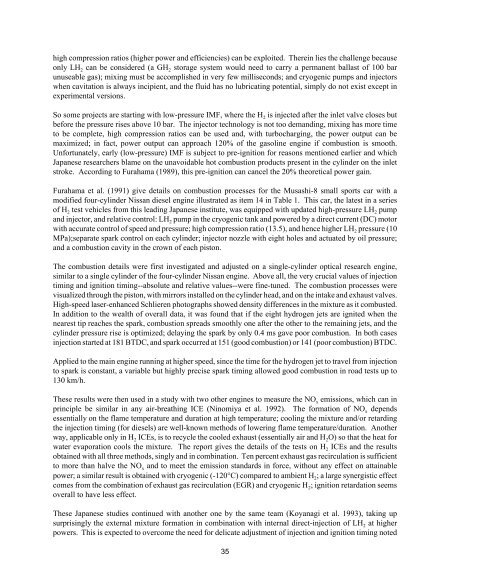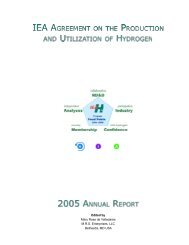Technology Status of Hydrogen Road Vehicles
Technology Status of Hydrogen Road Vehicles
Technology Status of Hydrogen Road Vehicles
You also want an ePaper? Increase the reach of your titles
YUMPU automatically turns print PDFs into web optimized ePapers that Google loves.
high compression ratios (higher power and efficiencies) can be exploited. Therein lies the challenge because<br />
only LH 2 can be considered (a GH 2 storage system would need to carry a permanent ballast <strong>of</strong> 100 bar<br />
unuseable gas); mixing must be accomplished in very few milliseconds; and cryogenic pumps and injectors<br />
when cavitation is always incipient, and the fluid has no lubricating potential, simply do not exist except in<br />
experimental versions.<br />
So some projects are starting with low-pressure IMF, where the H 2 is injected after the inlet valve closes but<br />
before the pressure rises above 10 bar. The injector technology is not too demanding, mixing has more time<br />
to be complete, high compression ratios can be used and, with turbocharging, the power output can be<br />
maximized; in fact, power output can approach 120% <strong>of</strong> the gasoline engine if combustion is smooth.<br />
Unfortunately, early (low-pressure) IMF is subject to pre-ignition for reasons mentioned earlier and which<br />
Japanese researchers blame on the unavoidable hot combustion products present in the cylinder on the inlet<br />
stroke. According to Furahama (1989), this pre-ignition can cancel the 20% theoretical power gain.<br />
Furahama et al. (1991) give details on combustion processes for the Musashi-8 small sports car with a<br />
modified four-cylinder Nissan diesel engine illustrated as item 14 in Table 1. This car, the latest in a series<br />
<strong>of</strong> H 2 test vehicles from this leading Japanese institute, was equipped with updated high-pressure LH 2 pump<br />
and injector, and relative control: LH 2 pump in the cryogenic tank and powered by a direct current (DC) motor<br />
with accurate control <strong>of</strong> speed and pressure; high compression ratio (13.5), and hence higher LH 2 pressure (10<br />
MPa);separate spark control on each cylinder; injector nozzle with eight holes and actuated by oil pressure;<br />
and a combustion cavity in the crown <strong>of</strong> each piston.<br />
The combustion details were first investigated and adjusted on a single-cylinder optical research engine,<br />
similar to a single cylinder <strong>of</strong> the four-cylinder Nissan engine. Above all, the very crucial values <strong>of</strong> injection<br />
timing and ignition timing--absolute and relative values--were fine-tuned. The combustion processes were<br />
visualized through the piston, with mirrors installed on the cylinder head, and on the intake and exhaust valves.<br />
High-speed laser-enhanced Schlieren photographs showed density differences in the mixture as it combusted.<br />
In addition to the wealth <strong>of</strong> overall data, it was found that if the eight hydrogen jets are ignited when the<br />
nearest tip reaches the spark, combustion spreads smoothly one after the other to the remaining jets, and the<br />
cylinder pressure rise is optimized; delaying the spark by only 0.4 ms gave poor combustion. In both cases<br />
injection started at 181 BTDC, and spark occurred at 151 (good combustion) or 141 (poor combustion) BTDC.<br />
Applied to the main engine running at higher speed, since the time for the hydrogen jet to travel from injection<br />
to spark is constant, a variable but highly precise spark timing allowed good combustion in road tests up to<br />
130 km/h.<br />
These results were then used in a study with two other engines to measure the NO x emissions, which can in<br />
principle be similar in any air-breathing ICE (Ninomiya et al. 1992). The formation <strong>of</strong> NO x depends<br />
essentially on the flame temperature and duration at high temperature; cooling the mixture and/or retarding<br />
the injection timing (for diesels) are well-known methods <strong>of</strong> lowering flame temperature/duration. Another<br />
way, applicable only in H 2 ICEs, is to recycle the cooled exhaust (essentially air and H 2O) so that the heat for<br />
water evaporation cools the mixture. The report gives the details <strong>of</strong> the tests on H 2 ICEs and the results<br />
obtained with all three methods, singly and in combination. Ten percent exhaust gas recirculation is sufficient<br />
to more than halve the NO x and to meet the emission standards in force, without any effect on attainable<br />
power; a similar result is obtained with cryogenic (-120°C) compared to ambient H 2; a large synergistic effect<br />
comes from the combination <strong>of</strong> exhaust gas recirculation (EGR) and cryogenic H 2; ignition retardation seems<br />
overall to have less effect.<br />
These Japanese studies continued with another one by the same team (Koyanagi et al. 1993), taking up<br />
surprisingly the external mixture formation in combination with internal direct-injection <strong>of</strong> LH 2 at higher<br />
powers. This is expected to overcome the need for delicate adjustment <strong>of</strong> injection and ignition timing noted<br />
35













